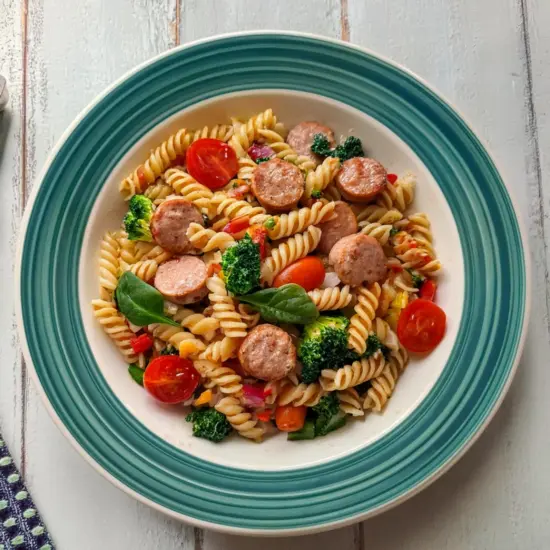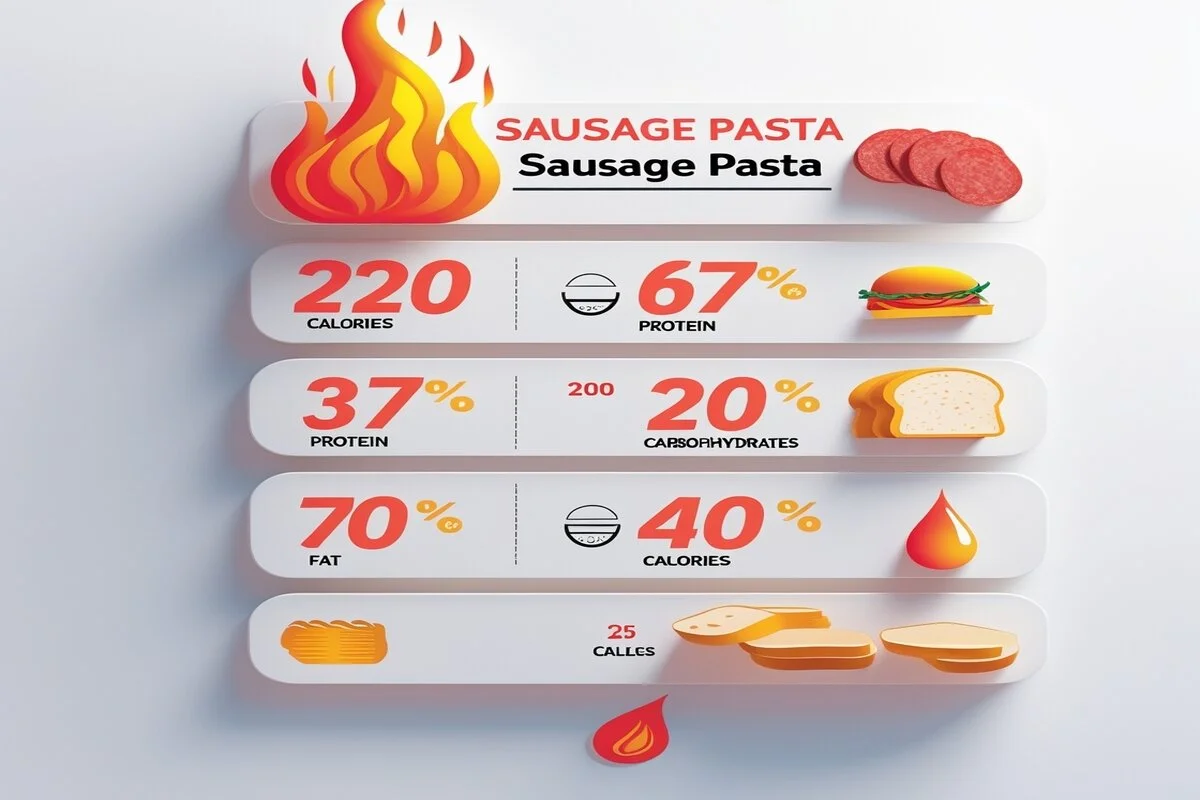Introduction : How Many Calories Are in Sausage Pasta? A Complete Nutritional Guide
Sausage pasta is an internationally cherished dish, adored for its rich, comforting flavors and the simplicity that makes it both accessible and enjoyable to prepare. However, understanding how many calories are in sausage pasta is crucial for making informed dietary choices. This comprehensive guide will not only break down the calorie content but also delve into variations of sausage pasta while offering a detailed recipe you can easily recreate at home. Furthermore, it provides valuable insights into ingredients, nutritional facts, and practical calorie-conscious adaptations, making this article your ultimate resource for everything related to sausage pasta.
Understanding How Many Calories Are in Sausage Pasta
Why Caloric Awareness Matters in Sausage Pasta
Calorie counting may not sound exciting, but it’s an essential aspect of maintaining a balanced diet. When indulging in sausage pasta, understanding the calorie content of sausage pasta can help you enjoy the dish while staying on track with your nutritional goals. After all, who doesn’t love savoring a meal guilt-free?
Sausage pasta, similar to many other pasta dishes, can vary significantly in caloric content based on the specific ingredients used and the preparation method chosen. These factors play a crucial role in shaping its overall nutritional profile. For instance, the type of sausage you choose—whether it’s a rich Italian sausage or a lean poultry alternative—makes a noticeable difference. Similarly, the choice of pasta and sauce adds or reduces calories.
Breaking Down the Ingredients
To understand the calories in sausage pasta, you need to consider its main components:
- Sausage: The calorie content of sausages can vary greatly depending on the type, which underscores the importance of selecting one that not only complements your flavor preferences but also aligns with your nutritional goals. Italian sausage, known for its robust flavor, often contains more calories than leaner options.
- Pasta: Traditional pasta like orecchiette or spaghetti is calorie-dense, but healthier choices like chickpea or whole-wheat pasta can lower the total count.
- Additional Ingredients: Olive oil, cheese, and sauces also contribute significantly to the calorie count. Cream-based sauces are typically higher in calories compared to tomato-based or olive oil-based alternatives.
Common Calorie Estimates for Sausage Pasta
On average, a standard serving of sausage pasta contains around 600–800 calories. However, this number can increase or decrease depending on portion size and modifications. For example:
- A cream-based sausage pasta dish can reach 900 calories per serving.
- Using lean sausage and whole-wheat pasta can lower the count to 450–500 calories.
Cultural Variations in Sausage Pasta and Their Impact on Calories
Interestingly, the calorie content of sausage pasta also varies by region. In Southern Italy, for example, this dish often includes broccoli rabe, which adds fiber and reduces calorie density. On the other hand, recipes in the U.S. may lean heavily on cheese and cream, pushing up the calorie count.
Tips for Balancing Calories While Enjoying Sausage Pasta
Even if you’re calorie-conscious, you can still enjoy sausage pasta. Try these tips:
- Substitute cream sauces with lighter options like tomato or pesto.
- Incorporate more vegetables, such as zucchini or spinach, to increase volume without significantly increasing calories.
- Opt for a smaller serving size and pair it with a salad for a satisfying meal.

Exploring Sausage Varieties in Sausage Pasta Recipes
How Different Sausages Impact the Caloric Content of Pasta
When it comes to determining how many calories are in sausage pasta, the type of sausage you choose can make all the difference.Sausages can differ significantly when it comes to their flavor, texture, and, perhaps most importantly, their caloric content, making your choice a key factor in crafting a dish that meets your preferences and dietary goals. While some sausages add richness and depth to the dish, others provide a lighter and leaner alternative.
Popular Types of Sausages Used in Sausage Pasta
- Italian Sausage
- Italian sausage is a staple ingredient in sausage pasta recipes, and notably, it is celebrated for its bold and savory flavor. In fact, it often features a delicious blend of spices, such as fennel, garlic, and red pepper flakes. Moreover, these spices work together to create a rich and distinctive taste that enhances the overall dish. As a result, Italian sausage remains a popular choice for adding depth and flavor to pasta recipes.
- Calorie Content: Approximately 250–300 calories per 100g.
- While delicious, it’s on the higher end of the calorie spectrum.
- Chicken or Turkey Sausage
- Poultry-based sausages are excellent for those seeking a lower-calorie option. They offer a similar texture to traditional sausage without the extra fat.
- Calorie Content: Roughly 150–180 calories per 100g.
- Perfect for calorie-conscious individuals without compromising flavor.
- Plant-Based Sausage Alternatives
- Vegan sausages made from ingredients like soy, pea protein, or mushrooms are increasingly popular.
- Calorie Content: Around 120–200 calories per 100g, depending on the brand.
- They’re a great way to make your dish more sustainable and nutritious.
Comparing Sausage Varieties: Calories and Nutrition
| Sausage Type | Calories (per 100g) | Protein (g) | Fat (g) | Carbs (g) |
|---|---|---|---|---|
| Italian Sausage | 250–300 | 16–18 | 20–25 | 2–3 |
| Chicken/Turkey Sausage | 150–180 | 18–22 | 6–8 | 1–2 |
| Vegan Sausage | 120–200 | 12–15 | 6–10 | 5–8 |
How to Choose the Right Sausage for Your Recipe
Selecting the right sausage largely depends on both your dietary goals and your flavor preferences. If you’re looking to enjoy a traditional experience, Italian sausage makes an excellent choice because it provides a bold and robust flavor that effortlessly enhances the overall taste of the dish. However, if you’re aiming to reduce the calorie count, chicken or turkey sausage is an excellent alternative. Meanwhile, plant-based options cater to those seeking a vegan-friendly twist.
The Role of Pasta in Sausage Pasta Calories
How Pasta Type Affects Caloric Content
When calculating how many calories are in sausage pasta, the type of pasta you choose plays a significant role. Traditional pasta varieties, such as orecchiette or spaghetti, are calorie-dense and contribute heavily to the overall count. However, alternative pasta options can help reduce calories while boosting nutritional value.
Popular Pasta Types in Sausage Pasta Recipes
- Traditional White Pasta
- Made from refined flour, this is the most common type of pasta used in sausage pasta recipes.
- Calorie Content: About 130–150 calories per 100g cooked.
- Offers a classic texture but lacks fiber and nutrients compared to alternatives.
- Whole Wheat Pasta
- Whole wheat pasta is a healthier option for those seeking more fiber and nutrients.
- Calorie Content: Around 120–140 calories per 100g cooked.
- Adds a nutty flavor and pairs well with robust sausage flavors.
- Legume-Based Pasta
- Chickpea, lentil, or black bean pasta are gaining popularity for their high protein and fiber content.
- Calorie Content: Approximately 110–130 calories per 100g cooked.
- Ideal for adding nutritional value while lowering the glycemic index of the dish.
- Gluten-Free Pasta
- Typically made from rice, quinoa, or corn, these options cater to those with gluten sensitivities.
- Calorie Content: Varies between 120–150 calories per 100g cooked, depending on the ingredients.
- A suitable alternative for gluten-free diets.
Comparing Pasta Options: Calories and Nutrition
| Pasta Type | Calories (per 100g cooked) | Protein (g) | Fiber (g) | Carbs (g) |
|---|---|---|---|---|
| White Pasta | 130–150 | 4–6 | 1–2 | 28–30 |
| Whole Wheat Pasta | 120–140 | 5–7 | 3–5 | 25–28 |
| Legume-Based Pasta | 110–130 | 7–9 | 4–7 | 18–22 |
| Gluten-Free Pasta | 120–150 | 3–5 | 1–2 | 30–35 |
Cooking Pasta for Calorie Control
Cooking techniques also impact calorie content. For example, cooking pasta al dente can lower its glycemic index, helping maintain stable blood sugar levels. Additionally, rinsing pasta after cooking reduces surface starch, which can slightly decrease its caloric density.
Tips for Choosing the Right Pasta
- Pair whole wheat or legume-based pasta with sausage for a hearty, fiber-rich meal.
- When catering to dietary restrictions, opting for gluten-free pasta is a great choice, as it helps meet specific dietary needs while ensuring that the dish retains its delicious flavor and satisfying texture.
- Experiment with portion sizes to balance calories and ensure a satisfying meal.
Recipe for Classic Sausage Pasta
Ingredients for Sausage Pasta
- 250g Italian sausage (or chicken sausage for a lighter option)
- 200g orecchiette or pasta of your choice
- 150g broccoli florets
- 2 tablespoons olive oil
- 3 garlic cloves, minced
- 1/4 cup grated Parmesan cheese (plus extra for garnish)
- 1/2 teaspoon red pepper flakes (optional)
- Salt and pepper to taste
Step-by-Step Cooking Instructions
- Prepare the Ingredients
- Start by slicing the sausage into bite-sized pieces. Wash and chop the broccoli into small florets.
- Cook the Pasta
- Bring a large pot of salted water to a boil. Add the pasta and cook al dente according to package instructions. Reserve 1/2 cup of pasta water before draining.
- Cook the Sausage
- In a large skillet, heat olive oil over medium heat. Add the sausage and cook until browned and fully cooked, about 5–7 minutes. Remove and set aside.
- Sauté the Garlic and Broccoli
- In the same skillet, add a little more olive oil if needed. Sauté the minced garlic until fragrant, about 1 minute. Add the broccoli florets and cook until tender-crisp, about 5 minutes.
- Combine Ingredients
- Return the cooked sausage to the skillet. Toss in the drained pasta and mix well. Gradually add the reserved pasta water to create a silky sauce.
- Season and Serve
- Next, stir in the Parmesan cheese and red pepper flakes, ensuring the flavors are evenly distributed, and then adjust the seasoning with a pinch of salt and pepper to taste. Finally, serve the dish warm, garnished with a touch of extra cheese and an additional sprinkle of red pepper flakes for those who enjoy a bit of extra heat.”List of Foods by Protein Content“
Nutritional Content of Sausage Pasta
Understanding the Nutritional Breakdown of Sausage Pasta
To fully appreciate how many calories are in sausage pasta, it’s crucial to take a closer look at its nutritional composition and understand how its ingredients contribute to the overall profile. For instance, the dish seamlessly blends a variety of macronutrients—carbohydrates from the pasta, proteins from the sausage, and fats introduced by the cheese and olive oil—all working together to create a deliciously balanced meal. Together, these components work seamlessly to create a meal that is not only flavorful but also deeply satisfying.:
Nutritional Content (Per 100g)
| Nutrient | Amount (Per 100g) | % Daily Value |
|---|---|---|
| Calories | 180 | 9% |
| Protein | 8g | 16% |
| Total Fat | 10g | 15% |
| Saturated Fat | 3g | 15% |
| Carbohydrates | 15g | 5% |
| Fiber | 2g | 8% |
| Sodium | 350mg | 15% |
| Sugars | 1g | 1% |

Nutritional Content (Per Serving: Approx. 250g)
| Nutrient | Amount (Per Serving) | % Daily Value |
|---|---|---|
| Calories | 450 | 22% |
| Protein | 20g | 40% |
| Total Fat | 25g | 38% |
| Saturated Fat | 8g | 40% |
| Carbohydrates | 38g | 13% |
| Fiber | 5g | 20% |
| Sodium | 900mg | 39% |
| Sugars | 3g | 3% |
Key Nutritional Insights
- Protein-Packed
- The sausage and Parmesan cheese contribute to a high protein content, making this dish a satisfying main course.
- Moderate Carbs
- The pasta provides energy-rich carbohydrates, while whole wheat or legume-based options offer added fiber.
- Fat Considerations
- The olive oil and sausage add healthy fats, but saturated fats from the cheese and sausage should be moderated.
- Sodium Levels
- While flavorful, this dish can be high in sodium. Opt for low-sodium sausages and cheeses if necessary.
Frequently Asked Questions (FAQs)
How can I reduce the calorie content of sausage pasta?
To reduce calories, use whole wheat or legume-based pasta and lean protein options like chicken sausage. You can also add more vegetables to increase volume while keeping calories low.
Are there healthier sausage alternatives?
Yes, plant-based sausages or turkey sausage are excellent low-calorie alternatives that retain the dish’s hearty flavor.
What pasta types are lower in calories?
Legume-based or shirataki noodles are lower in calories compared to traditional white pasta. These alternatives also offer more nutrients.
Can I make a vegetarian version of sausage pasta?
Certainly! For a vegetarian-friendly twist, you can easily substitute the sausage with plant-based crumbles. Alternatively, you could opt for hearty vegetables like mushrooms and zucchini to add texture and flavor. In addition, these options not only make the dish suitable for vegetarians but also enhance its nutritional value. As a result, you can enjoy a delicious and wholesome version of sausage pasta while catering to dietary preferences. These alternatives not only provide a satisfying texture but also enhance the dish with their unique flavors.
How does portion size affect calorie intake?
Smaller portions significantly reduce calorie intake. Pairing smaller servings with a side salad can make the meal more balanced.
Is sausage pasta freezer-friendly?
Absolutely, sausage pasta freezes exceptionally well. To preserve its flavor and texture, divide it into airtight containers and, when reheating, add a splash of water or broth to restore its freshness for the best results.
Balancing Flavor and Calories in Sausage Pasta
Making Calorie-Conscious Adjustments Without Sacrificing Taste
Lowering the calorie count doesn’t have to mean sacrificing flavor. In fact, by making a few thoughtful adjustments to the ingredients, you can still savor sausage pasta while creating a healthier and more balanced version of this beloved dish.
- Use Olive Oil Sparingly
- While olive oil adds richness, limiting the quantity reduces fat content without affecting taste too much.
- Choose Leaner Sausage
- Turkey or chicken sausages are flavorful yet lower in fat and calories compared to pork options.
- Incorporate Vegetables
- Adding zucchini, spinach, or bell peppers enhances the dish’s volume and nutritional profile.
- Experiment with Herbs and Spices
- Use garlic, red pepper flakes, and basil for flavor instead of relying heavily on cheese.
- Mind Portion Sizes
- Serving sizes play a critical role in managing calorie intake. Stick to about 1 cup of pasta per person.
Why Sausage Pasta is a Balanced Meal
A Nutritional Powerhouse
Sausage pasta is more than just a comforting dish; it’s a well-rounded meal that brings together a thoughtful balance of essential macronutrients and valuable micronutrients, making it both satisfying and nourishing. The sausage offers protein and fats, while the pasta provides energy-rich carbohydrates. Adding vegetables enhances the fiber and vitamin content, making this dish nutritious as well as delicious.
- High in Protein
- Protein is critical for muscle repair and overall health. Sausage and cheese both contribute significant amounts of protein to this dish.
- Carbohydrate Content
- Pasta is a great source of energy, and when you choose whole wheat or legume-based varieties, you gain the additional benefit of slow-digesting carbohydrates. These carbs are essential for helping maintain consistent and steady energy levels throughout the day.
- Healthy Fats
- Olive oil provides monounsaturated fats, which are heart-healthy. Reducing saturated fat intake by moderating cheese and sausage portions is also beneficial. “Understanding Sausage Ingredients“
Incorporating Sausage Pasta into a Balanced Diet
Integrating sausage pasta into your diet can align with your health goals through mindful adjustments. By choosing whole-grain pasta and leaner sausage varieties, you can reduce calorie intake without sacrificing flavor. Adding vegetables boosts the nutrient content, making the dish more wholesome. With careful portion control and strategic ingredient swaps, sausage pasta becomes a healthier choice that fits seamlessly into a balanced eating plan. Moderation is key; by planning thoughtfully, you can savor this flavorful dish without compromising your dietary objectives. With these simple tweaks, sausage pasta transforms into a nutritious, satisfying meal that supports a healthy lifestyle.
- Pair with Greens
- A fresh side salad or steamed vegetables balances the dish and increases its nutrient density.
- Limit High-Calorie Additions
- Reduce or eliminate heavy cream and excess cheese to control calorie intake without losing flavor.
- Stay Active
- Incorporate physical activity to offset the caloric intake of a hearty pasta meal.
Conclusion
Sausage pasta is an incredibly versatile dish that continues to be cherished for its rich, bold flavors and delightfully satisfying texture, making it a favorite in many households.However, knowing how many calories are in sausage pasta empowers you to make smarter choices. Whether you prefer it with creamy sauce, lean proteins, or extra vegetables, this dish adapts to your taste and dietary needs.
By following this guide, you’ll not only understand its nutritional content but also learn how to customize the recipe for a balanced lifestyle. Whether you’re indulging in its classic preparation or experimenting with healthier variations, sausage pasta remains a timeless favorite that’s both flavorful and fulfilling.

